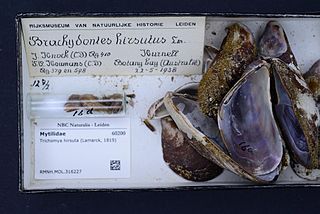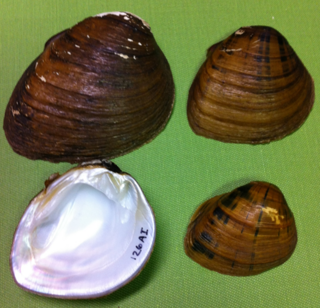
Mussel is the common name used for members of several families of bivalve molluscs, from saltwater and freshwater habitats. These groups have in common a shell whose outline is elongated and asymmetrical compared with other edible clams, which are often more or less rounded or oval.

Bivalvia, in previous centuries referred to as the Lamellibranchiata and Pelecypoda, is a class of marine and freshwater molluscs that have laterally compressed bodies enclosed by a shell consisting of two hinged parts. As a group, bivalves have no head and they lack some usual molluscan organs, like the radula and the odontophore. The class includes the clams, oysters, cockles, mussels, scallops, and numerous other families that live in saltwater, as well as a number of families that live in freshwater. The majority are filter feeders. The gills have evolved into ctenidia, specialised organs for feeding and breathing. Most bivalves bury themselves in sediment, where they are relatively safe from predation. Others lie on the sea floor or attach themselves to rocks or other hard surfaces. Some bivalves, such as the scallops and file shells, can swim. Shipworms bore into wood, clay, or stone and live inside these substances.

The New Zealand pea crab, is a species of small, parasitic crab that lives most commonly inside New Zealand green-lipped mussels. Adult females are about the size and shape of a pea, while adult males are smaller and flatter. Adult New Zealand pea crabs are completely reliant on their host mussel for shelter and food, which it steals from the mussel's gills. The New Zealand pea crab is found throughout New Zealand and can infect up to 70% of natural populations. These crabs are of concern to green-lipped mussel aquaculture because they reduce the size and growth of mussels, although infected mussels can be harvested and consumed.

Pinctada is a genus of saltwater oysters, marine bivalve mollusks in the family Pteriidae. These pearl oysters have a strong inner shell layer composed of nacre, also known as "mother of pearl".

The Unionidae are a family of freshwater mussels, the largest in the order Unionida, the bivalve molluscs sometimes known as river mussels, or simply as unionids.

The freshwater pearl mussel is an endangered species of freshwater mussel, an aquatic bivalve mollusc in the family Margaritiferidae.

Margaritiferidae is a family of medium-sized freshwater mussels, aquatic bivalve molluscs in the order Unionida. It is the most threatened of all unionid families.

Unionida is a monophyletic order of freshwater mussels, aquatic bivalve molluscs. The order includes most of the larger freshwater mussels, including the freshwater pearl mussels. The most common families are the Unionidae and the Margaritiferidae. All have in common a larval stage that is temporarily parasitic on fish, nacreous shells, high in organic matter, that may crack upon drying out, and siphons too short to permit the animal to live deeply buried in sediment.

Margaritifera is a genus of freshwater mussels, aquatic bivalve molluscs in the family Margaritiferidae, the freshwater pearl mussels.

Integrated multi-trophic aquaculture (IMTA) provides the byproducts, including waste, from one aquatic species as inputs for another. Farmers combine fed aquaculture with inorganic extractive and organic extractive aquaculture to create balanced systems for environment remediation (biomitigation), economic stability and social acceptability.

Cultured freshwater pearls are pearls that are farmed and created using freshwater mussels. These pearls are produced in Japan and the United States on a limited scale, but are now almost exclusively produced in China. The U.S. Federal Trade Commission requires that farmed freshwater pearls be referred to as "freshwater cultured pearls" in commerce. Quality of cultured freshwater pearls is evaluated through a grading system of a series of A values, based on luster, shape, surface, colour and matching.

Amblema is a genus of freshwater mussels, aquatic bivalve mollusks in the family Unionidae, the river mussels.

Margaritifera auricularia is a species of European freshwater mussel, an aquatic bivalve mollusk in the family Margaritiferidae, the freshwater pearl mussels. Formerly found throughout western and central Europe, the species is now critically endangered and is one of the rarest invertebrates worldwide, being confined to a few rivers in Spain and France. M. auricularia is commonly known as Spengler's freshwater mussel in honour of Lorenz Spengler, who first described this species.
Freshwater bivalves are one kind of freshwater mollusc, along with freshwater snails. They are bivalves that live in fresh water as opposed to salt water, which is the main habitat type for bivalves.

Amblema plicata, common name the threeridge, is a species of freshwater mussel, an aquatic bivalve mollusk in the family Unionidae, the river mussels.

Acheilognathus macropterus is a species of cyprinid fish native to China and northern Vietnam. It grows to a length of 27.5 centimetres (10.8 in) SL.

Trichomya is a monotypic genus of marine bivalve molluscs in the family Mytilidae, the mussels. The only species is Trichomya hirsuta which is endemic to southern and eastern Australia. Its common names include the hairy mussel, the greenling and the kelp greenling.

Cristaria plicata, the cockscomb pearl mussel, is a freshwater mussel, an aquatic bivalve mollusk in the family Unionidae.

Pleuronaia dolabelloides, the slab-sided naiad, slab-sided pearly mussel, or slabside pearlymussel, is a species of freshwater mussel, an aquatic bivalve mollusk in the family Unionidae, the river mussels. This species was formerly classified under the genus Lexingtonia.

Aquaculture in the United Kingdom is dominated by salmon farming, then by mussel production with trout being the third most important enterprise. Aquaculture in the United Kingdom represents a significant business for the UK, producing over 200,000 tonnes of fish whilst earning over £700 million in 2012 (€793 million).
















